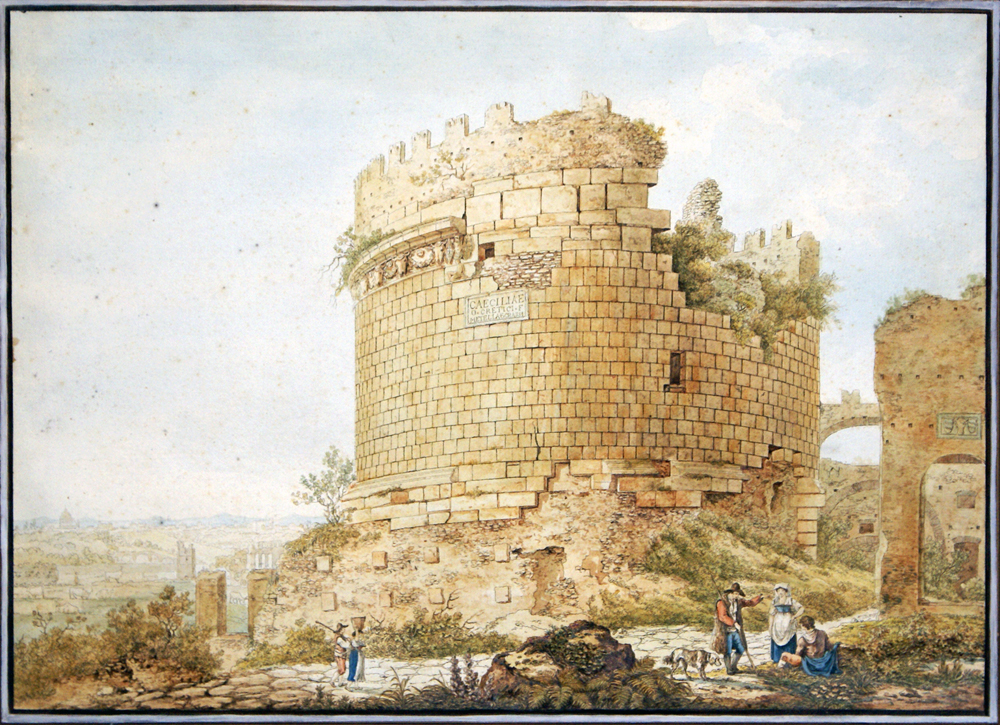

The Mausoleum of Cecilia Metella on the Appian Way
Watercolor over etched outline within wood and brass contemporary frame
Author: Kaisermann Franz (Swiss 1765-1833)
Dimension: cm 30x40, cm 60x70 with frame
Excellent condition commensurate with age
The Tomb of Caecilia Metella (Italian: Mausoleo di Cecilia Metella) is a mausoleum located just outside Rome at the three mile marker of the Via Appia. It was built during the 1st century BC to honor Caecilia Metella who was the daughter of Quintus Caecilius Metellus Creticus, a Consul in 69 BC, and wife of Marcus Licinius Crassus (quaestor), son of the famous Marcus Crassus who served under Julius Caesar. Located on top of a hill along the Via Appia, the Tomb of Caecilia Metella consists of a cylindrical drum, or rotunda, atop a square podium with the Caetani Castle (Castrum) attached at the rear. The square podium stands at 8.3 meters tall with the cylindrical drum standing at 12 m. The monument in totality stands at a height of 21.7 meters tall. The diameter of the circular drum is 29.5 m, equivalent to 100 Roman feet. On the outside of the monument, an inscription can be seen reading "CAECILIAE |Q·CRETICI·F | METELLAE·CRASSI" indicating to whom this tomb was dedicated. Further up the monument, decorations can be seen depicting festoons and bucrania, heads of bulls, which were the inspiration for the area being named Capo Di Bove, meaning head of the bovine. At the top of the monument, medieval battlements can be seen from the time when the tomb was used as a fortress. At the rear, the Caetani Castle is attached to the tomb. The castle originally was three levels: ground level, first level, and second level. It is unknown what the second level was used for but the first floor was used for the elite gentlemen as evidenced by fireplaces and refined goods. The castle is now used to display various decorations from the monument.
The Mausoleum of Cecilia Metella on the Appian Way
Watercolor over etched outline within wood and brass contemporary frame
Author: Kaisermann Franz (Swiss 1765-1833)
Dimension: cm 30x40, cm 60x70 with frame
Excellent condition commensurate with age
The Tomb of Caecilia Metella (Italian: Mausoleo di Cecilia Metella) is a mausoleum located just outside Rome at the three mile marker of the Via Appia. It was built during the 1st century BC to honor Caecilia Metella who was the daughter of Quintus Caecilius Metellus Creticus, a Consul in 69 BC, and wife of Marcus Licinius Crassus (quaestor), son of the famous Marcus Crassus who served under Julius Caesar. Located on top of a hill along the Via Appia, the Tomb of Caecilia Metella consists of a cylindrical drum, or rotunda, atop a square podium with the Caetani Castle (Castrum) attached at the rear. The square podium stands at 8.3 meters tall with the cylindrical drum standing at 12 m. The monument in totality stands at a height of 21.7 meters tall. The diameter of the circular drum is 29.5 m, equivalent to 100 Roman feet. On the outside of the monument, an inscription can be seen reading "CAECILIAE |Q·CRETICI·F | METELLAE·CRASSI" indicating to whom this tomb was dedicated. Further up the monument, decorations can be seen depicting festoons and bucrania, heads of bulls, which were the inspiration for the area being named Capo Di Bove, meaning head of the bovine. At the top of the monument, medieval battlements can be seen from the time when the tomb was used as a fortress. At the rear, the Caetani Castle is attached to the tomb. The castle originally was three levels: ground level, first level, and second level. It is unknown what the second level was used for but the first floor was used for the elite gentlemen as evidenced by fireplaces and refined goods. The castle is now used to display various decorations from the monument.


















































